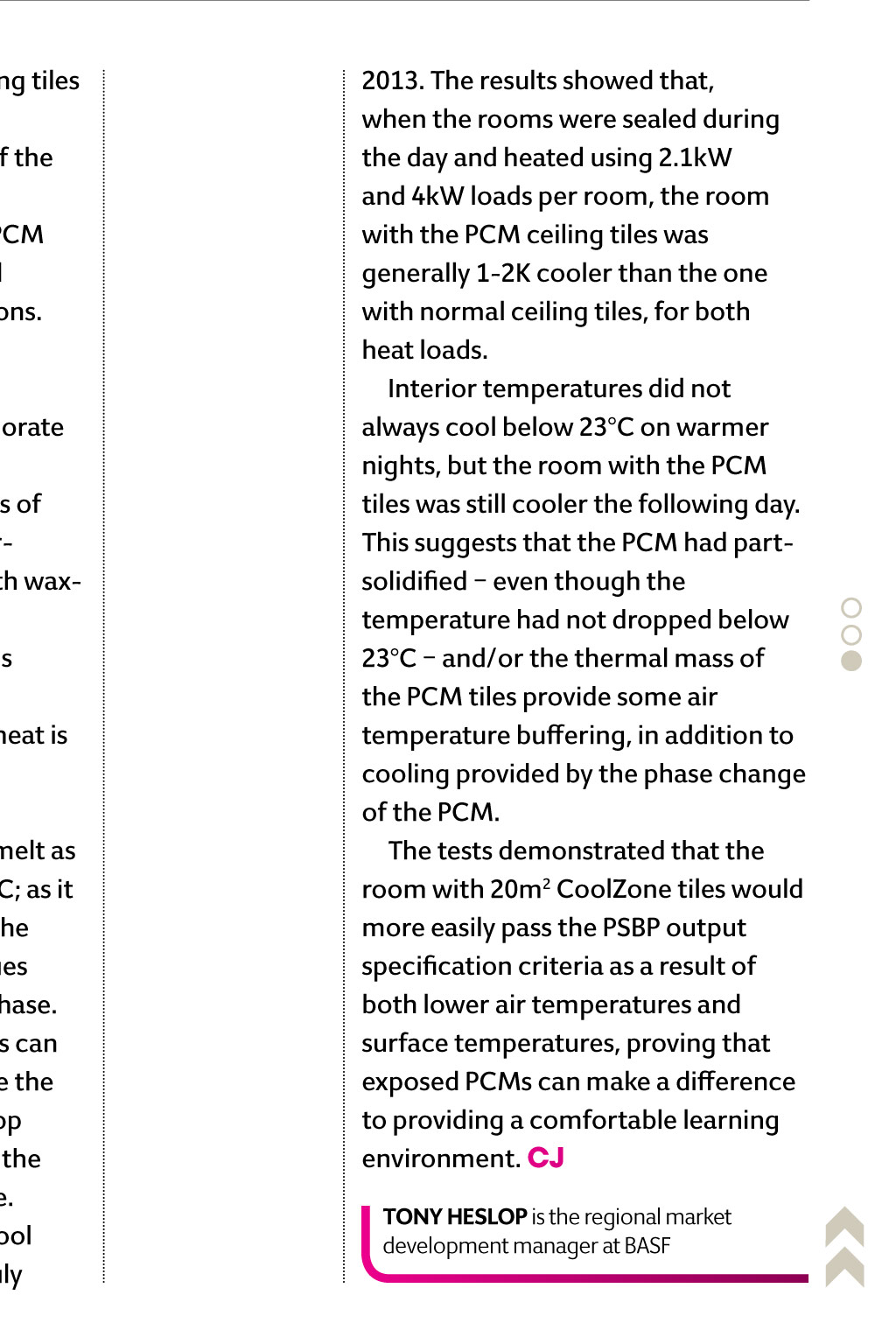












Phase Change Materials Case Study Going through A phase PCM viewed under a microscope [Source: BaSF] have been built with a large area of exposed concrete or brickwork to enjoy the benefits of thermal mass. Such heavyweight construction forms can increase time on site and cost more to build than a lightweight structure. A cost-effective alternative is to build a school using lightweight construction techniques and add exposed thermal mass in the form of phase change materials (PCMs). Tests in a Nottinghamshire school have shown that adding phase change material to a classroom can significantly improve comfort conditions. Tony Heslop, of BASF, explains In these tiles, the microencapsulated wax will start to melt as air temperatures approach 23C; as it does so, it soaks up heat from the room The school, built in 2009 to comply with BB101, is a lightweight construction. Two identical, 58m2, first-floor classrooms were selected for the test. Each had through-theroof ventilation units installed. These were sized to meet summertime overheating requirements and minimum daily average ventilation demands, to limit room CO2 levels. Each room had opening windows and a conventional suspended ceiling, Room temperature comparison 28 26 Temperature (oC) t he Priority Schools Building Programme (PSBP) successor to Building Schools for the Future offers a new approach to that of Building Bulletin 101 (BB101), including the use of exposed thermal mass in classrooms to reduce the risk of overheating. The presence of exposed thermal mass, such as a concrete surface, allows heat to be absorbed from a space during the day to help keep it cool. This heat is then given out by the thermal mass when it is cooled using night-time ventilation. Another advantage of exposed thermal mass is that, during the day, it will heat up more slowly than a lightweight material. As a result, it has a lower surface temperature, providing additional comfort to occupants. In the past, a room would probably PCMs absorb far more thermal energy than equivalent conventional material, because they change phase usually from a solid to liquid and back again at room temperature. Breathing Buildings worked with Armstrong Ceilings to investigate the impact of retrofitting thermal mass in the form of PCMs to a classroom at Belvoir High School, Bottesford, Nottinghamshire. 24 22 20 normal room 18 30/05 04/06 09/06 14/06 19/06 24/06 PCM room 29/06 04/07 Date Below-ceiling peak air temperature consistently lower in room with PCM in ceiling tiles formed from 600x600mm ceiling tiles supported on a metal grid. In one of the classrooms, half the conventional ceiling tiles were replaced by tiles with integral PCM to test the impact of additional thermal mass on room conditions. The tiles covered an area of approximately 20m2. The metal ceiling tiles incorporate BASFs Micronal phase change material, comprising thousands of microscopically small, polymerencapsulated spheres, each with waxcore latent-heat storage. Since melting and solidifying happens inside each microcapsule, the material remains solid, even if heat is being taken up or released. In these tiles, the microencapsulated wax will start to melt as air temperatures approach 23C; as it does so, it soaks up heat from the room. Heat absorption continues until all the wax has changed phase. Using night ventilation, the tiles can release this absorbed heat once the room temperature starts to drop below 23C. As it releases heat, the PCM will return to its solid state. The tests at Belvoir High School took place between May and July 2013. The results showed that, when the rooms were sealed during the day and heated using 2.1kW and 4kW loads per room, the room with the PCM ceiling tiles was generally 1-2K cooler than the one with normal ceiling tiles, for both heat loads. Interior temperatures did not always cool below 23C on warmer nights, but the room with the PCM tiles was still cooler the following day. This suggests that the PCM had partsolidified even though the temperature had not dropped below 23C and/or the thermal mass of the PCM tiles provide some air temperature buffering, in addition to cooling provided by the phase change of the PCM. The tests demonstrated that the room with 20m2 CoolZone tiles would more easily pass the PSBP output specification criteria as a result of both lower air temperatures and surface temperatures, proving that exposed PCMs can make a difference to providing a comfortable learning environment. cJ Tony HESLoP is the regional market development manager at BASF